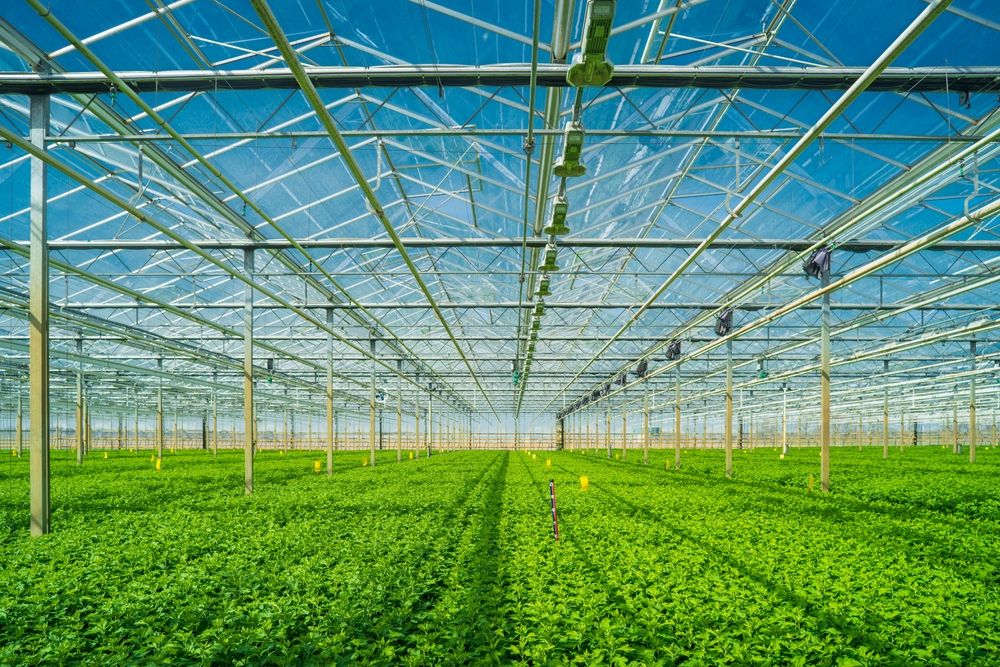Climate Change and the Impact on The Horticultural Industry
)
Climate change is no longer a distant concern; it's a reality affecting various sectors, including horticulture, which plays a critical role in our global food system and contributes to biodiversity. The shifts in weather patterns, temperature and environmental conditions are reshaping the horticulture industry in significant ways.
From changes in plant growth cycles to the impact on greenhouse operations, the industry faces a unique set of challenges and opportunities. This article explores how climate change is influencing horticulture and what these changes mean for the future of the industry.
The Role of Peatlands in Carbon Storage
Peatlands, often overlooked in discussions about climate change, are among the most crucial ecosystems. They are the largest natural carbon store, despite covering just 3% of the earth's surface, holding more than all the world's forests combined. Peatlands cover just 3% of the Earth's land surface, yet they store twice as much carbon as all the trees in the world. This incredible capacity makes them vital in the fight against climate change. However, their role in horticulture, primarily as a growing medium, has raised significant environmental concerns.
The extraction of peat for horticultural use, such as in compost and soil conditioners, leads to the degradation of these essential carbon sinks. Peat is harvested, it releases stored carbon into the atmosphere, contributing to greenhouse gas emissions. This practice is not only unsustainable but also counterproductive in the context of global efforts to mitigate climate change. As awareness of this issue grows, the horticulture industry is under increasing pressure to find alternatives to peat-based products.
Sustainable alternatives, such as coir (coconut fibre), bark, and wood-based products, are being explored, but the transition is not without its challenges. These substitutes need to meet the high standards set by peat in terms of water retention, nutrient availability, and ease of use. The industry must balance environmental concerns with the need for effective growing media, ensuring that the shift away from peat does not negatively impact crop production.
The Early Blooming of UK Plants
One of the most noticeable effects of climate change in the horticulture industry is the shift in the timing of natural events, known as plant phenology. In the UK, studies have shown that plants are now flowering almost a month earlier than they did just a few decades ago. This change is largely driven by warmer temperatures, which have accelerated the growth cycles of many plant species.
While the sight of early blooms might seem like a harmless or even pleasant outcome, it carries significant implications for the ecosystem and the horticulture industry. Early flowering can disrupt the delicate balance between plants and their pollinators, such as bees, butterflies, and other insects. These creatures rely on specific plants blooming at certain times of the year to provide them with food. If the timing is off, it can lead to a mismatch, where flowers bloom before pollinators are ready, or worse, before they have emerged from their winter dormancy.
This mismatch can reduce the effectiveness of pollination, leading to lower fruit and seed production. For horticulturists, this means that crop yields could be adversely affected, necessitating changes in planting schedules and pest management strategies. Moreover, early flowering can increase the vulnerability of plants to late frosts, which can damage flowers and reduce crop productivity. This shifting phenology is a clear indication of how climate change is already impacting horticulture, requiring proactive adjustments from those in the industry.

Crop Yields and Quality
As global temperatures continue to rise, the horticulture industry is experiencing a mix of benefits and drawbacks. On one hand, warmer temperatures and elevated levels of carbon dioxide (CO2) can boost plant growth and increase crop yields. This happens because CO2 is a key component of photosynthesis, the process by which plants convert sunlight into energy. Higher concentrations of CO2 can enhance this process, leading to faster growth and potentially higher yields for some crops.
However, these potential benefits are tempered by several significant challenges. One major concern is the effect of warmer winter temperatures on the quality of produce stored at ambient temperatures. Many fruits and vegetables are traditionally stored in cool conditions after harvest to slow down the ripening process and extend their shelf life. Warmer winters can make it difficult to maintain these optimal storage conditions, leading to faster spoilage and a decline in the nutritional quality of the produce.
Additionally, some fruit varieties require a period of chilling during the winter months to trigger flowering and fruiting in the spring. As winters become milder, these chilling requirements may no longer be met, potentially leading to reduced fruit production. This situation may necessitate the breeding of new fruit varieties that are less dependent on cold temperatures, presenting both a challenge and an opportunity for horticultural science.
For horticulturists, the changing climate requires a rethinking of crop selection, storage practices, and even the types of crops that can be grown in certain regions. The industry must adapt to these new conditions to ensure that both the quantity and quality of produce are maintained in the face of climate change.
Changing Rainfall Patterns
Another significant impact of climate change on horticulture is the alteration of rainfall patterns. The intensity and frequency of heavy summer and autumn rainfall events are expected to increase, posing a range of challenges for crop cultivation. Excessive rainfall can lead to waterlogging, soil erosion, and nutrient leaching, all of which can harm crops and reduce yields.
Waterlogging occurs when the soil becomes saturated with water, leaving no room for air. This lack of oxygen can suffocate plant roots, leading to reduced growth or even the death of the plant. Waterlogged conditions also create an ideal environment for root diseases, which can further damage crops. In extreme cases, fields may become too wet to work, delaying planting and potentially shortening the growing season.
Soil erosion is another major concern, particularly on sloping fields. Heavy rains can wash away the topsoil, which is the most fertile layer, rich in organic matter and nutrients. This loss of topsoil can severely reduce the productivity of the land, making it more difficult for crops to thrive.
Nutrient leaching occurs when excessive rainfall washes nutrients out of the soil, making them unavailable to plants. This can lead to nutrient deficiencies, which in turn can reduce crop yields and quality. Farmers may need to apply more fertilisers to compensate for these losses, but this approach is not without its downsides. Increased fertiliser use can lead to environmental issues such as water pollution and greenhouse gas emissions.
The changing rainfall patterns also disrupt the timing of planting and harvesting. Crops may need to be planted earlier or later than usual to avoid the worst of the weather, but this can create a ripple effect through the rest of the growing season. For horticulturists, these shifts require careful planning and adaptation to ensure that crops are not only planted and harvested on time but also that they receive the right amount of water and nutrients throughout the growing season.
Nutrient Uptake and Soil Health
The impact of climate change on nutrient uptake by crops is a less visible but equally important issue for the horticulture industry. The availability of nutrients in the soil is influenced by a range of factors, including temperature, moisture levels, and soil composition—all of which are being affected by climate change.
Warmer temperatures can speed up the decomposition of organic matter in the soil, which releases nutrients such as nitrogen, phosphorus, and potassium. While this might initially seem beneficial, the rapid breakdown of organic matter can lead to a depletion of these nutrients over time, reducing soil fertility. Moreover, the accelerated decomposition process can increase the release of CO2 from the soil, contributing further to greenhouse gas emissions.
Changes in precipitation patterns, as previously mentioned, can lead to nutrient leaching, where valuable nutrients are washed out of the soil before plants can absorb them. This not only affects the current crop but can also degrade the soil quality for future plantings. In some cases, the soil may become so degraded that it can no longer support certain types of crops, forcing farmers to switch to less demanding plants or abandon the land altogether.
The balance of nutrients in the soil is also crucial for the health and productivity of crops. An imbalance, such as an excess of nitrogen without sufficient phosphorus, can lead to poor plant growth and reduced yields. As climate change alters the availability of different nutrients, horticulturists will need to monitor soil conditions more closely and adjust their fertilisation practices to maintain soil health.

Greenhouse Gas Emissions and Energy Use
Greenhouses are a vital tool for the horticulture industry, allowing for the cultivation of crops in controlled environments, especially in regions with less favourable outdoor conditions. However, operating greenhouses is energy-intensive, with heating alone accounting for up to 90% of the energy used. This heavy reliance on heating makes greenhouse operations a significant contributor to greenhouse gas emissions.
Studies have shown that the energy used to heat greenhouses for crops such as tomatoes, cucumbers, and flowers is the largest factor in their overall carbon footprint. As the world moves towards reducing carbon emissions, the horticulture industry is under pressure to make greenhouse operations more sustainable. This challenge is particularly acute in colder regions, where the demand for heating is highest.
To address these concerns, the industry is exploring several strategies to reduce the carbon footprint of greenhouses. One approach is to improve the energy efficiency of greenhouse structures, such as by using better insulation, energy-efficient heating systems, and advanced climate control technologies. Another strategy is to shift towards renewable energy sources, such as solar or geothermal energy, to power greenhouse operations.
The use of renewable energy not only reduces greenhouse gas emissions but can also lower operating costs in the long term, making it an economically viable option for many growers. Additionally, integrating energy storage solutions, like batteries or thermal storage, can help smooth out the energy supply, ensuring that greenhouses remain heated even when renewable energy sources are not producing at full capacity.
The horticulture industry stands at a critical juncture as it grapples with the multifaceted impacts of climate change. From the early blooming of plants to the challenges posed by altered rainfall patterns and warmer winters, the industry must adapt to a rapidly changing environment. While there are potential benefits, such as increased yields from higher CO2 levels, these are often accompanied by significant challenges, including reduced produce quality and increased environmental impact.
The need for innovation and adaptation has never been greater. The industry must explore sustainable practices, such as developing new crop varieties that can thrive in warmer climates, improving the efficiency of greenhouse operations, and finding alternatives to peat-based growing media. By taking proactive steps, the horticulture industry can continue to flourish in the face of climate change while contributing to global efforts to mitigate its effects.
Ultimately, the future of horticulture depends on the industry's ability to embrace change and implement sustainable trends and solutions. Through innovation, collaboration, and a commitment to environmental stewardship, the horticulture industry can not only survive but thrive in a changing climate, ensuring the continued availability of fresh, nutritious produce for generations to come.
Would you like to share your expertise? We invite you to contribute a guest post to Glee! Your insights can inspire and educate our readers while boosting your own visibility in the community.
We welcome well-researched articles, how-to guides, and personal stories that add value to our audience.
If you’re interested, see here to submit your guest post today! We look forward to hearing from you.
